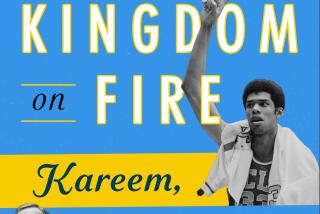Another Two-Handed Shot for the Ol’ Whittier Y
- Share via
The fund-raising dinner for the Whittier YMCA’s new building was held in the cavernous gymnasium of the old Y on Hadley Street. There were perhaps 500 residents present.
The evening began with an invocation and ended with a benediction. The speeches emphasized the healthful Christian influence of the Y on Whittier’s young. Evidently the libertine trends of postwar society had not undermined the Quaker foundations of the town.
Whittier had been the quintessential Prohibition town. Even when Franklin Roosevelt brought liquor back, Whittier remained dry until finally the Hoover Hotel, improbably, installed a bar.
I was no sooner in the gym than I was joined by what was left of the team--the YMCA’s 95-pound basketball team of 1930-31. (Our weight limit was 95 pounds.) Someone had prepared a large photograph of the team, posed in two rows in our basketball suits. There were nine of us, with Shorty Kellog, our coach, standing at the center rear.
Some are dead now. But Wayne Wilson, Gordie Ferguson, Earl Maple, Arvle Dedmon, Gene Bishop and I were right there, shaking hands. Wilson had been the star. The team sometimes scored as many as 20 or 30 points, and Wilson was usually the high-point man. Jack Clinton was at front and center, with the ball between his feet. Clinton was tall, and handsome as a movie star. Nobody knew what had become of him.
I had printed out a copy of a Whittier reminiscence I had written for a magazine years ago. I intended to read it as my speech. When I arrived at the Y, however, I saw that it wasn’t in the car. I remembered putting it on top of the car while I unlocked the door. Evidently I had driven off with it still on top, and it had blown away.
All I could do was tell some twice-told tales and talk about the team. I pointed out that Wilson had always been high-point man because I had fed him the ball, having taken it away from the other team and dribbled down the court while Wilson was heading toward the basket for one of his patented layups. But in those days the statisticians did not count assists. Wilson went on to become a star at Whittier College while I faded into obscurity.
I recalled also that I had developed the one-handed jump shot--the first player in the country to use it. However, I was thwarted in this revolutionary gambit by Shorty Kellog, who was much given to axioms, one of which was “Two hands are better than one.” Every time I essayed a one-handed shot Shorty would take me out of the game and solemnly remind me, “Two hands are better than one.”
As Hank Luisetti was to demonstrate a few years later at Stanford University, the axiom was plainly not true. Thus Luisetti got fame and credit for something I had invented at the age of 13. The one-handed jump shot today is a mainstay of the game.
I also reminded my audience that, while they might not believe it to look at me now, I had once been the 108-pound wrestling champion of the Whittier Y. I conceded that they might not have believed it to look at me then, either.
In the team picture I was notably skinny, though I had the slick good looks of Rudolph Valentino. Actually, there were only two of us in the 108-pound class. I defeated the other fellow, who was rather slow, by jumping up every time he threw me.
The championship matches were held before our parents.
My father always claimed that I had not actually pinned my opponent, and Shorty Kellog had tapped me three times on the shoulder--the victory sign--because he was afraid the match would never end, the way I kept jumping up. It was a question that remained in dispute at my father’s death.
After my talk they made us old-timers put on numbered basketball shirts, gave us a ball and had us shoot at a basket. I took a one-handed shot and missed. The ball came back to me. I put it up with two hands and swished it like Byron Scott.
Wayne Wilson was standing beside me. He said, “Two hands are better than one.”
I’m calling that shot my Shorty Kellog memorial shot.


